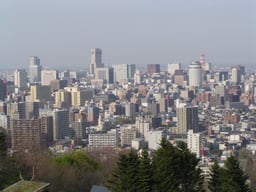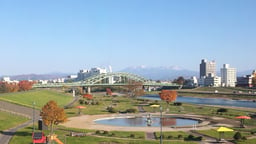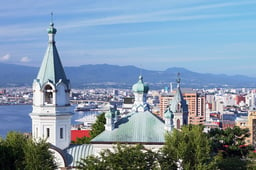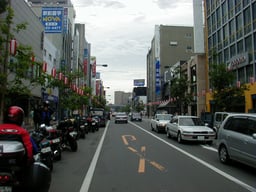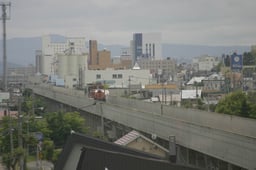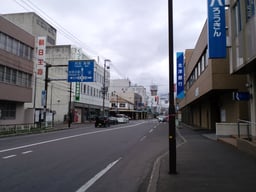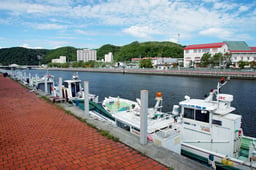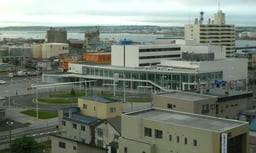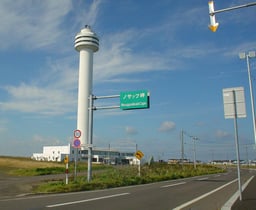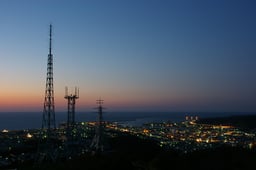Hokkaido
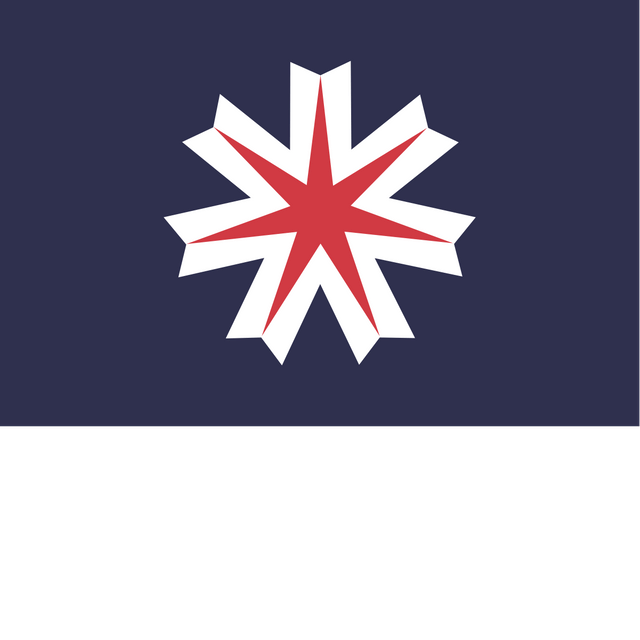
Hokkaido

Hokkaido 北海道 | |
|---|---|
Prefecture | |
| Japanese transcription(s) | |
| • Japanese | 北海道 |
| • Rōmaji | Hokkaidō |
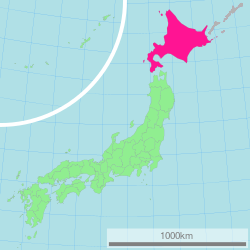 | |
| Country | Japan |
| Region | Hokkaido |
| Island | Hokkaido |
| Capital | Sapporo |
| Largest city | Capital |
| Subdivisions | ****Districts: 74, Municipalities: 179 |
| Government | |
| • Governor | Naomichi Suzuki |
| Area | |
| • Total | 83,423.84 km2(32,210.12 sq mi) |
| Area rank | 1st |
| Population (May 31, 2019) | |
| • Total | 5,281,297 |
| • Rank | 8th |
| • Density | 63/km2(160/sq mi) |
| ISO 3166 code | JP-01 |
| Website | www.pref.hokkaido.lg.jp [51] |
| Symbols | |
| Bird | Tanchō (red-crowned crane, Grus japonensis) |
| Flower | Hamanasu (rugosa rose, Rosa rugosa) |
| Tree | Ezomatsu (Jezo spruce, Picea jezoensis) |
| Native name: 北海道 | |
 | |
| Geography | |
| Location | East Asia |
| Coordinates | 43°N 142°E [52] |
| Archipelago | Japanese archipelago |
| Area | 77,981.87 km2(30,108.97 sq mi) |
| Highest elevation | 2,290 m (7,510 ft) |
| Highest point | Mount Asahi |
| Administration | |
Japan | |
| Prefectures | Hokkaido |
| Largest settlement | Sapporo (pop. 1,890,561) |
| Demographics | |
| Population | 5,377,435 (September 30, 2016) |
| Pop. density | 64.5 /km2(167.1 /sq mi) |
| Ethnic groups | Ainu Japanese |
Hokkaido (北海道, Hokkaidō, lit. "Northern Sea Circuit"; Japanese: [hokːaꜜidoː] (listen), English: /hɒˈkaɪdoʊ/) is the second largest main island of Japan, and the largest and northernmost prefecture.[1] The Tsugaru Strait separates Hokkaido from Honshu. It was formerly known as Ezo, Yezo, Yeso, or Yesso.[2] The two islands are connected by the undersea railway Seikan Tunnel. The largest city on Hokkaido is its capital, Sapporo, which is also its only ordinance-designated city. About 43 kilometres north of Hokkaido lies Sakhalin Island and to the east and northeast are the Kuril Islands, which are administered by Russia, although the four most southerly are claimed by Japan—see Kuril Islands dispute.
Hokkaido 北海道 | |
|---|---|
Prefecture | |
| Japanese transcription(s) | |
| • Japanese | 北海道 |
| • Rōmaji | Hokkaidō |
 | |
| Country | Japan |
| Region | Hokkaido |
| Island | Hokkaido |
| Capital | Sapporo |
| Largest city | Capital |
| Subdivisions | ****Districts: 74, Municipalities: 179 |
| Government | |
| • Governor | Naomichi Suzuki |
| Area | |
| • Total | 83,423.84 km2(32,210.12 sq mi) |
| Area rank | 1st |
| Population (May 31, 2019) | |
| • Total | 5,281,297 |
| • Rank | 8th |
| • Density | 63/km2(160/sq mi) |
| ISO 3166 code | JP-01 |
| Website | www.pref.hokkaido.lg.jp [51] |
| Symbols | |
| Bird | Tanchō (red-crowned crane, Grus japonensis) |
| Flower | Hamanasu (rugosa rose, Rosa rugosa) |
| Tree | Ezomatsu (Jezo spruce, Picea jezoensis) |
| Native name: 北海道 | |
 | |
| Geography | |
| Location | East Asia |
| Coordinates | 43°N 142°E [52] |
| Archipelago | Japanese archipelago |
| Area | 77,981.87 km2(30,108.97 sq mi) |
| Highest elevation | 2,290 m (7,510 ft) |
| Highest point | Mount Asahi |
| Administration | |
Japan | |
| Prefectures | Hokkaido |
| Largest settlement | Sapporo (pop. 1,890,561) |
| Demographics | |
| Population | 5,377,435 (September 30, 2016) |
| Pop. density | 64.5 /km2(167.1 /sq mi) |
| Ethnic groups | Ainu Japanese |
History

Palace reception near Hakodate in 1751. Ainu bringing gifts.

The samurai and the Ainu, c. 1775

Matsumae Takahiro, a Matsumae lord of the late Edo period. December 10, 1829 – June 9, 1866
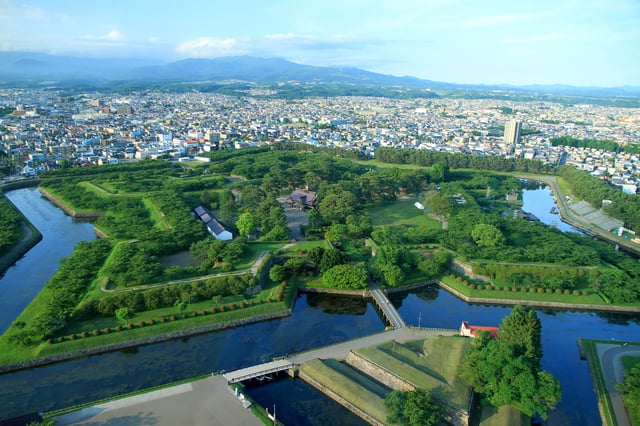
Goryōkaku
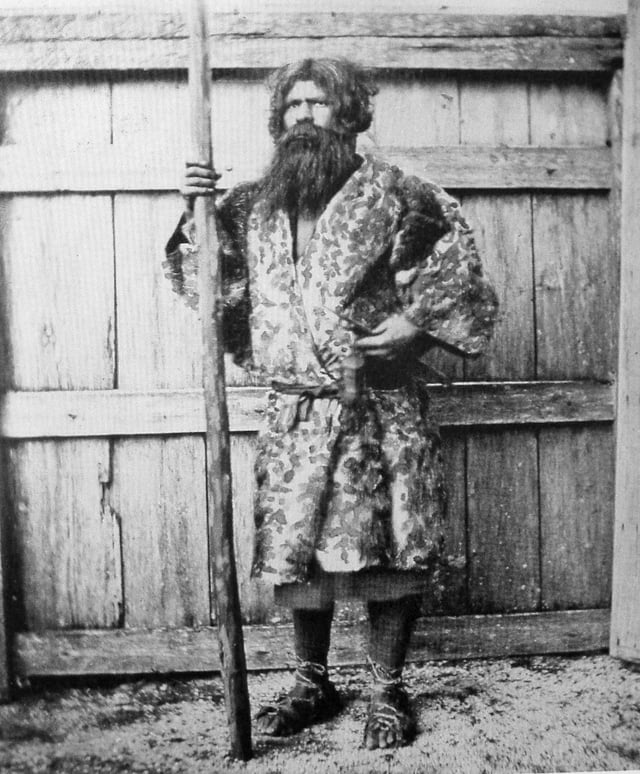
The Ainu, Hokkaido's indigenous people
| Historical population | ||
|---|---|---|
| Year | Pop. | ±% p.a. |
| 1890 | 414,430 | — |
| 1903 | 1,089,503 | +7.72% |
| 1920 | 2,359,183 | +4.65% |
| 1930 | 2,812,335 | +1.77% |
| 1940 | 3,272,718 | +1.53% |
| 1950 | 4,295,567 | +2.76% |
| 1960 | 5,039,206 | +1.61% |
| 1970 | 5,184,287 | +0.28% |
| 1980 | 5,575,989 | +0.73% |
| 1990 | 5,643,647 | +0.12% |
| 2000 | 5,683,062 | +0.07% |
| 2010 | 5,506,419 | −0.32% |
| 2015 | 5,383,579 | −0.45% |
| source:[3] | ||
Jomon culture and the associated hunter-gatherer lifestyle flourished in Hokkaido, beginning over 15,000 years ago. Contrasting the Island of Honshu, Hokkaido saw an absence of conflict during this time period. Jomon beliefs in natural spirits are theorized to be the origins of Ainu spirituality. Beginning 2000 years ago, the island shifted towards Yayoi and much of the Island's population shifted away from hunting and gathering and towards agriculture.[4]
The Nihon Shoki, finished in 720 AD, is often said to be the first mention of Hokkaido in recorded history. According to the text, Abe no Hirafu[5] led a large navy and army to northern areas from 658 to 660 and came into contact with the Mishihase and Emishi. One of the places Hirafu went to was called Watarishima (渡島), which is often believed to be present-day Hokkaido. However, many theories exist concerning the details of this event, including the location of Watarishima and the common belief that the Emishi in Watarishima were the ancestors of the present-day Ainu people.
During the Nara and Heian periods (710–1185), people in Hokkaido conducted trade with Dewa Province, an outpost of the Japanese central government. From the Middle Ages, the people in Hokkaido began to be called Ezo. Hokkaido subsequently became known as Ezochi (蝦夷地, lit. "Ezo-land")[6] or Ezogashima (蝦夷ヶ島, lit. "Island of the Ezo"). The Ezo mainly relied upon hunting and fishing and obtained rice and iron through trade with the Japanese.
During the Muromachi period (1336–1573), the Japanese created a settlement at the south of the Oshima Peninsula. As more people moved to the settlement to avoid battles, disputes arose between the Japanese and the Ainu. The disputes eventually developed into a war. Takeda Nobuhiro killed the Ainu leader, Koshamain,[5] and defeated the opposition in 1457. Nobuhiro's descendants became the rulers of the Matsumae-han, which was granted exclusive trading rights with the Ainu in the Azuchi-Momoyama and Edo periods (1568–1868). The Matsumae family's economy relied upon trade with the Ainu. They held authority over the south of Ezochi until the end of the Edo period in 1868.
The Matsumae clan rule over the Ainu must be understood in the context of the expansion of the Japanese feudal state. Medieval military leaders in northern Honshū (ex. Northern Fujiwara, Akita clan) maintained only tenuous political and cultural ties to the imperial court and its proxies, the Kamakura Shogunate and Ashikaga Shogunate. Feudal strongmen sometimes located themselves within medieval institutional order, taking shogunal titles, while in other times they assumed titles that seemed to give them a non-Japanese identity. In fact, many of the feudal strongmen were descended from Emishi military leaders who had been assimilated into Japanese society.[7] The Matsumae clan were of Yamato descent like other ethnic Japanese people, whereas the Emishi of northern Honshu were a distinctive group related to the Ainu. The Emishi were conquered and integrated into the Japanese state dating back as far as the 8th century, and as result began to lose their distinctive culture and ethnicity as they became minorities. By the time the Matsumae clan ruled over the Ainu most of the Emishi were ethnically mixed and physically closer to Japanese than they were to Ainu. This dovetails nicely with the "transformation" theory that native Jōmon peoples changed gradually with the infusion of Yayoi immigrants into the Tōhoku rather than the "replacement" theory which posits that one population (Jōmon) was replaced by another (Yayoi).[8]
There were numerous revolts by the Ainu against the feudal rule. The last large-scale resistance was Shakushain's Revolt in 1669–1672. In 1789, a smaller movement, the Menashi–Kunashir rebellion, was also crushed. After that rebellion, the terms "Japanese" and "Ainu" referred to clearly distinguished groups, and the Matsumae were unequivocally Japanese. In 1799–1821 and 1855–1858, the Edo Shogunate took direct control over Hokkaido in response to a perceived threat from Russia.
Hokkaido was known as Ezochi until the Meiji Restoration. Shortly after the Boshin War in 1868, a group of Tokugawa loyalists led by Enomoto Takeaki temporarily occupied the island (the polity is commonly but mistakenly known as the Republic of Ezo), but the rebellion was crushed in May 1869. Ezochi was subsequently put under control of Hakodate-fu (箱館府), Hakodate Prefectural Government. When establishing the Development Commission (開拓使, Kaitakushi), the Meiji Government introduced a new name. After 1869, the northern Japanese island was known as Hokkaido;[2] and regional subdivisions were established, including the provinces of Oshima, Shiribeshi, Iburi, Ishikari, Teshio, Kitami, Hidaka, Tokachi, Kushiro, Nemuro and Chishima.[10]
The primary purpose of the development commission was to secure Hokkaido before the Russians extended their control of the Far East beyond Vladivostok. Kuroda Kiyotaka was put in charge of the venture. His first step was to journey to the United States and recruit Horace Capron, President Grant's Commissioner of Agriculture. From 1871 to 1873 Capron bent his efforts to expounding Western agriculture and mining with mixed results. Capron, frustrated with obstacles to his efforts returned home in 1875. In 1876, William S. Clark arrived to found an agricultural college in Sapporo. Although he only remained a year, Clark left a lasting impression on Hokkaido, inspiring the Japanese with his teachings on agriculture as well as Christianity.[11] His parting words, "Boys, be ambitious!", can be found on public buildings in Hokkaido to this day. The population of Hokkaido boomed from 58,000 to 240,000 during that decade.[12]
In 1882, the Development Commission was abolished. Transportation on the island was still underdeveloped, so the prefecture was split into several "sub-prefectures" (支庁 shichō), namely Hakodate Prefecture (函館県, Hakodate-ken), Sapporo Prefecture (札幌県, Sapporo-ken), and Nemuro Prefecture (根室県, Nemuro-ken), that could fulfill administrative duties of the prefectural government and keep tight control over the developing island. In 1886, the three prefectures were demoted, and Hokkaido was put under the Hokkaido Agency (北海道庁, Hokkaidō-chō). These sub-prefectures still exist today, although they have much less power than they possessed before and during World War II; they now exist primarily to handle paperwork and other bureaucratic functions.
In mid-July 1945, various shipping ports, cities and military facilities in Hokkaido were attacked by the United States Navy's Task Force 38. On the 14th and 15th of July that year, aircraft operating from the task force's aircraft carriers sank and damaged a large number of ships in ports along Hokkaido's southern coastline as well as in northern Honshu. In addition, on 15 July a force of three battleships and two light cruisers bombarded the city of Muroran.[13] Before the Japanese surrender was formalized, the Soviet Union made preparations for an invasion of Hokkaido, but President Harry Truman made it clear that the surrender of all of the Japanese home islands would be carried out by General MacArthur per the 1943 Cairo Declaration.[14]
Hokkaido became equal with other prefectures in 1947, when the revised Local Autonomy Law became effective. The Japanese central government established the Hokkaido Development Agency (北海道開発庁, Hokkaidō Kaihatsuchō) as an agency of the Prime Minister's Office in 1949 to maintain its executive power in Hokkaido. The Agency was absorbed by the Ministry of Land, Infrastructure and Transport in 2001. The Hokkaido Bureau (北海道局, Hokkaidō-kyoku) and the Hokkaido Regional Development Bureau (北海道開発局, Hokkaidō Kaihatsukyoku) of the Ministry still have a strong influence on public construction projects in Hokkaido.
Naming of Hokkaido
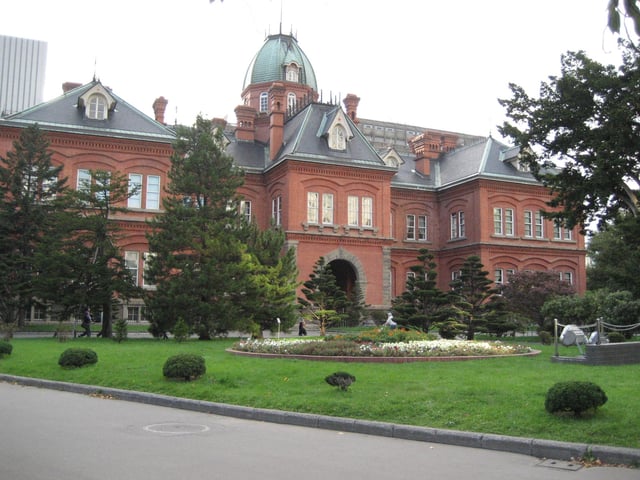
Former Hokkaidō Government Office in Chūō-ku, Sapporo
When establishing the Development Commission (開拓使, Kaitakushi), the Meiji Government decided to change the name of Ezochi. Matsuura Takeshirō submitted six proposals, including names such as Kaihokudō (海北道) and Hokkaidō (北加伊道), to the government. The government eventually decided to use the name Hokkaidō, but decided to write it as 北海道, as a compromise between 海北道 and 北加伊道 because of the similarity with names such as Tōkaidō (東海道). According to Matsuura, the name was thought up because the Ainu called the region Kai. Historically, many peoples who had interactions with the ancestors of the Ainu called them and their islands Kuyi, Kuye, Qoy, or some similar name, which may have some connection to the early modern form Kai. The Kai element also strongly resembles the On'yomi, or Sino-Japanese, reading of the characters 蝦夷 (on'yomi as [ka.i, カイ], kun'yomi as [e.mi.ɕi, えみし]) which have been used for over a thousand years in China and Japan as the standard orthographic form to be used when referring to Ainu and related peoples; it is possible that Matsuura's Kai was actually an alteration, influenced by the Sino-Japanese reading of 蝦夷 Ka-i, of the Nivkh exonym for the Ainu, namely Qoy or IPA: [kʰuɣɪ].[15]
There is no known established Ainu language word for the island of Hokkaido. However, the Ainu people did have a name for all of their domain, which included Hokkaido along with the Kuril Islands, Sakhalin, and parts of northern Honshu, which was Aynu Mosir (アィヌ・モシリ), a name taken by the modern Ainu to refer to their traditional homeland.[16][17][18][19][20] "Ainu Mosir" literally translates as "The Land Where People (the Ainu) Live", and it was traditionally used to be contrasted with Kamuy Mosir, "The Land of the Kamuy (spirits)".[21]
In 1947, Hokkaido became a full-fledged prefecture, but the -ken suffix was never added to its name, so the -dō suffix came to be understood to mean "prefecture". "Hokkai-do-ken" (literally "North Sea Province Prefecture") is, therefore, technically speaking, a redundant term, although it is occasionally used to differentiate the government from the island itself. The prefecture's government calls itself the "Hokkaido Government" rather than the "Hokkaido Prefectural Government".
Geography
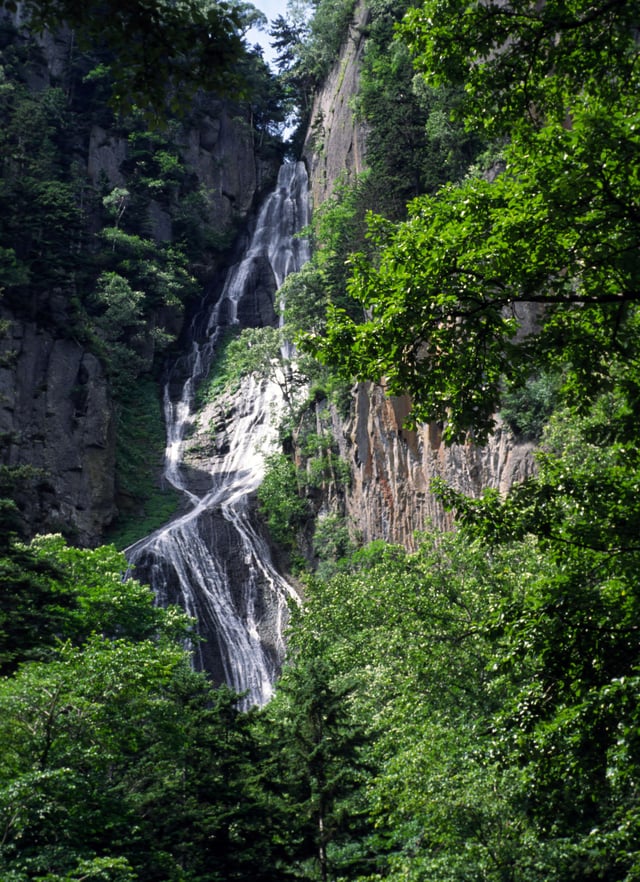
Sōunkyō, a gorge in the Daisetsu-zan Volcanic Area.
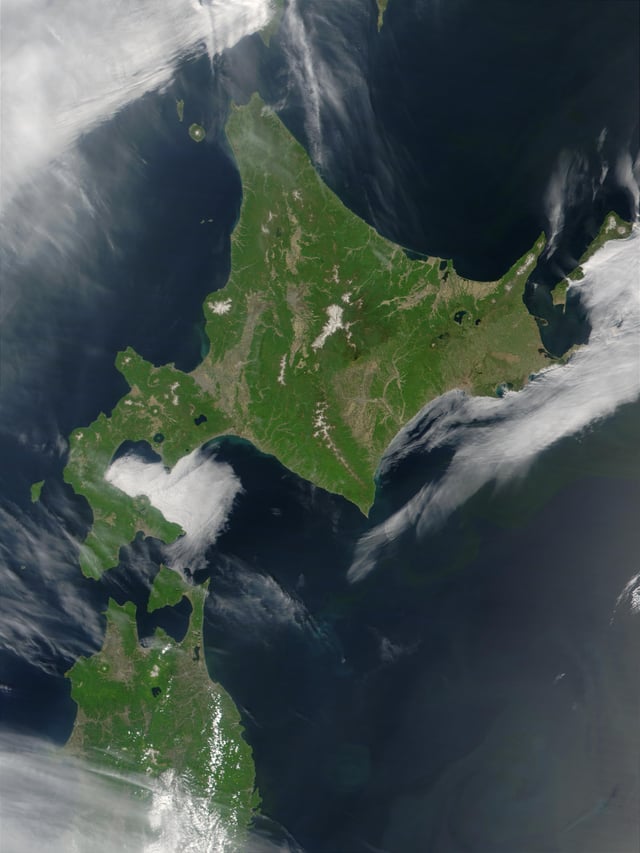
Satellite image of Hokkaido
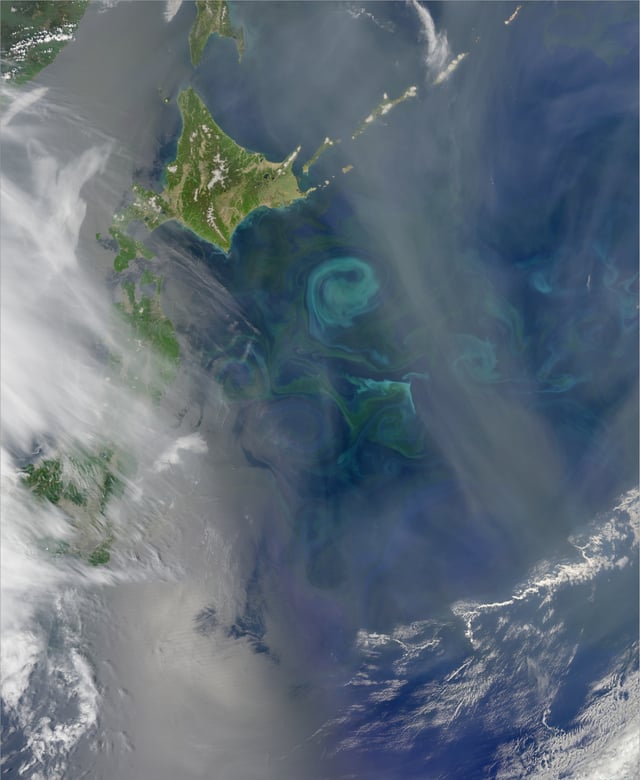
The Oyashio Current colliding with the Kuroshio Current off the coast of Hokkaido. When two currents collide, they create eddies. Phytoplankton growing in the surface waters become concentrated along the boundaries of these eddies, tracing out the motions of the water.
The island of Hokkaido is located at the north end of Japan, near Russia. It has coastlines on the Sea of Japan, the Sea of Okhotsk, and the Pacific Ocean. The center of the island has a number of mountains and volcanic plateaux. Hokkaido has multiple plains such as the Ishikari Plain 3,800 km2 (1,500 sq mi), Tokachi Plain 3,600 km2 (1,400 sq mi), the Kushiro Plain is the largest wetland in Japan 2,510 km2 (970 sq mi) and Sarobetsu Plain 200 km2 (77 sq mi). Hokkaido is 83,423.84 km2 (32,210.12 sq mi) which makes it the second largest island of Japan. The Tsugaru Strait separates Hokkaido from Honshu.[2]
The governmental jurisdiction of Hokkaido incorporates several smaller islands, including Rishiri, Okushiri Island, and Rebun. (By Japanese reckoning, Hokkaido also incorporates several of the Kuril Islands.) Because the prefectural status of Hokkaido is denoted by the dō in its name, it is rarely referred to as "Hokkaido Prefecture", except when necessary to distinguish the governmental entity from the island. It is the largest and northernmost prefecture. The island ranks 21st in the world by area. It is 3.6% smaller than the island of Ireland while Hispaniola is 6.1% smaller than Hokkaido.
In the east, there are two areas (surrounding, for example, Shari and the Nakashibetsu Airport) where a grid with spacing of nearly 3 km is formed by narrow bands of forest. It was designed to buffer wind, especially during blizzards, to protect cattle. It also serves as habitat and transportation corridors for animals and hikers.
Population
Hokkaido has the third largest population of the five main islands with 5,383,579 (2015)[1][22]. It has the lowest population density in Japan with just 64.5 km2 (24.9 sq mi) (2016). By population it ranks 20th, between Ireland and Sicily. Hokkaido's population is 4.7% less than the island of Ireland, and Sicily is 12% lower than Hokkaido.
Major cities include Sapporo and Asahikawa in the central region and the port of Hakodate facing Honshu in the south. Sapporo is the largest city of Hokkaido and 5th largest in Japan. It has a population of 1,957,914 (May 31, 2019) and a population density of 1,746 km2 (674 sq mi). Asahikawa is the second most populous city with 359.536 people (2016) and a density of 470.98 km2 (181.85 sq mi). It is near the island's geographic center. Third place is Hakodate with 279,851 people and 412.83 km2 (159.39 sq mi).
| City*(-shi)* | Inhabitants September 30, 2016 |
|---|---|
| Sapporo | 1.947.097 |
| Asahikawa | 343.393 |
| Hakodate | 266.192 |
| Kushiro | 174.938 |
| Tomakomai | 173.226 |
| Obihiro | 168.258 |
| Otaru | 121.269 |
| Kitami | 120.189 |
| Ebetsu | 119.247 |
| Muroran | 87.498 |
| Iwamizawa | 84.127 |
| Chitose | 96.372 |
| Eniwa | 69.215 |
Wildlife
There are three populations of the Hokkaido brown bear subspecies (Ursus arctos yesoensis). There are more brown bears in Hokkaido than anywhere else in Asia besides Russia. The Hokkaido brown bear is separated into three distinct lineages. There are only eight lineages in the world.[23] Those on Honshu died out long ago. Native conifer species in Northern Hokkaido is the Abies sachalinensis (sakhalin fir)[24] The Hydrangea hirta species is also located on this island.
Seismic activity
Like many areas of Japan, Hokkaido is seismically active. Aside from numerous earthquakes, the following volcanoes are still considered active (at least one eruption since 1850):
Mount Koma
Mount Usu and Shōwa-shinzan
Mount Tarumae
Mount Tokachi
Mount Meakan
In 1993, an earthquake of magnitude 7.7 generated a tsunami which devastated Okushiri, killing 202 inhabitants. An earthquake of magnitude 8.3 struck near the island on 26 September 2003.
On September 6, 2018, an earthquake of magnitude 6.6 struck, causing a blackout across the whole island; its epicenter was near the city of Tomakomai.[25]
National parks and quasi-national parks
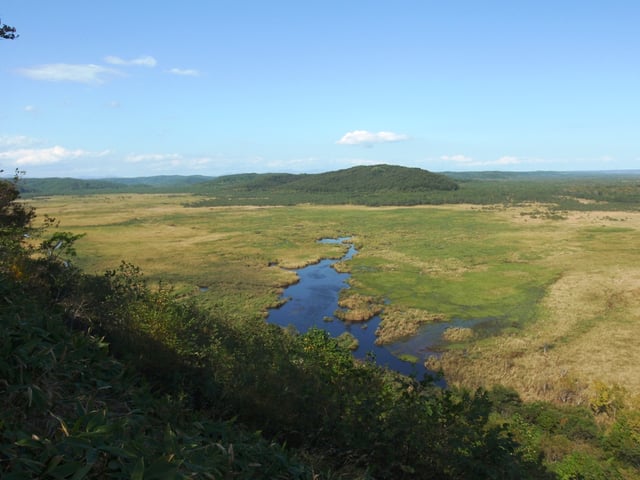
Overview of Kushiro Wetland

Lake Akan and Mount Meakan

View of Lake Mashū
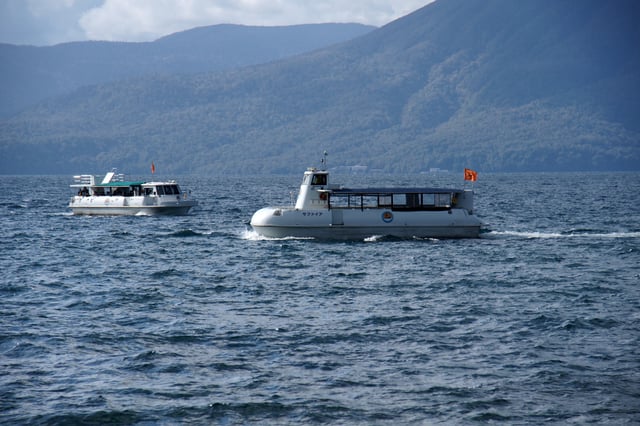
Lake Shikotsu
There exist many undisturbed forests in Hokkaido, including:
| Shiretoko National Park* | 知床 |
| Akan National Park | 阿寒 |
| Kushiro-shitsugen National Park | 釧路湿原 |
| Daisetsuzan National Park | 大雪山 |
| Shikotsu-Tōya National Park | 支笏洞爺 |
| Rishiri-Rebun-Sarobetsu National Park | 利尻礼文サロベツ |
- designated a World Heritage Site by UNESCO on 2005-07-14.
| Abashiri Quasi-National Park | 網走 |
| Hidaka-sanmyaku Erimo Quasi-National Park | 日高山脈襟裳 |
| Niseko-Shakotan-Otaru Kaigan Quasi-National Park | ニセコ積丹小樽海岸 |
| Ōnuma Quasi-National Park | 大沼 |
| Shokanbetsu-Teuri-Yagishiri Quasi-National Park | 暑寒別天売焼尻 |
Twelve prefectural natural parks (道立自然公園). The prefectural natural parks cover 146,802 ha, the largest area of any prefecture.[26] Akkeshi Prefectural Natural Park Esan Prefectural Natural Park Furano-Ashibetsu Prefectural Natural Park Hiyama Prefectural Natural Park Kariba-Motta Prefectural Natural Park Matsumae-Yagoshi Prefectural Natural Park North Okhotsk Prefectural Natural Park Nopporo Shinrin Kōen Prefectural Natural Park Notsuke-Fūren Prefectural Natural Park Sharidake Prefectural Natural Park Shumarinai Prefectural Natural Park Teshiodake Prefectural Natural Park
| since | ||
|---|---|---|
| Kushiro Wetland | 釧路湿原 | 1980-06-17 |
| Lake Kutcharo | クッチャロ湖 | 1989-07-06 |
| Lake Utonai | ウトナイ湖 | 1991-12-12 |
| Kiritappu Wetland | 霧多布湿原 | 1993-06-10 |
| Lake Akkeshi, Bekkanbeushi Wetland | 厚岸湖・別寒辺牛湿原 | 1993-06-10, enlarged 2005-11-08 |
| Miyajima Marsh | 宮島沼 | 2002-11-18 |
| Uryūnuma Wetland | 雨竜沼湿原 | 2005-11-08 |
| Sarobetsu plain | サロベツ原野 | |
| Lake Tōfutsu | 濤沸湖 | |
| Lake Akan | 阿寒湖 | |
| Notsuke Peninsula, Notsuke Bay | 野付半島・野付湾 | |
| Lake Fūren, Shunkunitai | 風蓮湖・春国岱 |
Subprefectures
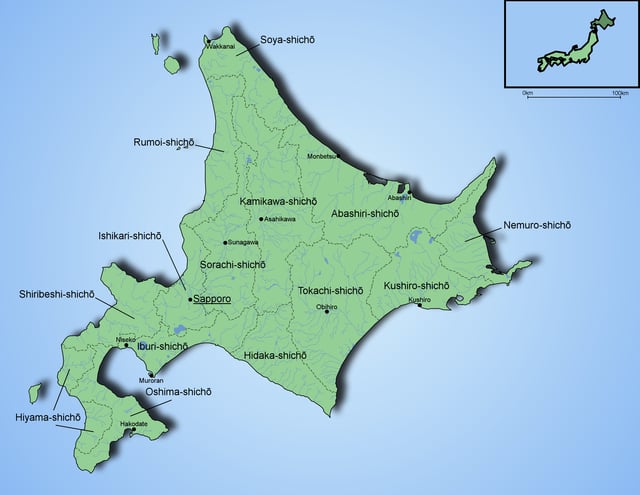
Map of Hokkaido showing the subprefectures and the primary cities
| Subprefecture | Japanese | Capital | Largest city | Pop. (2009) | Area (km2) | Municipalities | |||
|---|---|---|---|---|---|---|---|---|---|
| 1 | Sorachi | 空知総合振興局 | Iwamizawa | Iwamizawa | 338,485 | 5,791.19 | 10 cities | 14 towns | |
| a | ↳ Ishikari | 石狩振興局 | Sapporo | Sapporo | 2,324,878 | 3,539.86 | 6 cities | 1 town | 1 village |
| 2 | Shiribeshi | 後志総合振興局 | Kutchan | Otaru | 234,984 | 4,305.83 | 1 city | 13 towns | 6 villages |
| 3 | Iburi | 胆振総合振興局 | Muroran | Tomakomai | 419,115 | 3,698.00 | 4 cities | 7 towns | |
| b | ↳ Hidaka | 日高振興局 | Urakawa | Shinhidaka | 76,084 | 4,811.97 | 7 towns | ||
| 4 | Oshima | 渡島総合振興局 | Hakodate | Hakodate | 433,475 | 3,936.46 | 2 cities | 9 towns | |
| c | ↳ Hiyama | 檜山振興局 | Esashi | Setana | 43,210 | 2,629.94 | 7 towns | ||
| 5 | Kamikawa | 上川総合振興局 | Asahikawa | Asahikawa | 527,575 | 10,619.20 | 4 cities | 17 towns | 2 villages |
| d | ↳ Rumoi | 留萌振興局 | Rumoi | Rumoi | 53,916 | 3,445.75 | 1 city | 6 towns | 1 village |
| 6 | Sōya | 宗谷総合振興局 | Wakkanai | Wakkanai | 71,423 | 4,625.09 | 1 city | 8 towns | 1 village |
| 7 | Okhotsk | オホーツク総合振興局 | Abashiri | Kitami | 309,487 | 10,690.62 | 3 cities | 14 towns | 1 village |
| 8 | Tokachi | 十勝総合振興局 | Obihiro | Obihiro | 353,291 | 10,831.24 | 1 city | 16 towns | 2 villages |
| 9 | Kushiro | 釧路総合振興局 | Kushiro | Kushiro | 252,571 | 5,997.38 | 1 city | 6 towns | 1 village |
| e | ↳ Nemuro | 根室振興局 | Nemuro | Nemuro | 84,035 | 3,406.23 | 1 city | 4 towns | |
belong to Nemuro Subprefecture divided into six villages. However, the table above excludes these islands' data. | |||||||||
As of April 2010, Hokkaido has 9 General Subprefectural Bureaus (総合振興局) and 5 Subprefectural Bureaus (振興局). Hokkaido is one of eight prefectures in Japan that have subprefectures (支庁 shichō). However, it is the only one of the eight to have such offices covering the whole of its territory outside the main cities (rather than having them just for outlying islands or remote areas). This is mostly due to its great size; many parts of the prefecture are simply too far away to be effectively administered by Sapporo. Subprefectural offices in Hokkaido carry out many of the duties that prefectural offices fulfill elsewhere in Japan.
Between 1869 and the time leading up to the current political divisions, Hokkaido was divided into provinces. See Former provinces of Hokkaido.
Climate
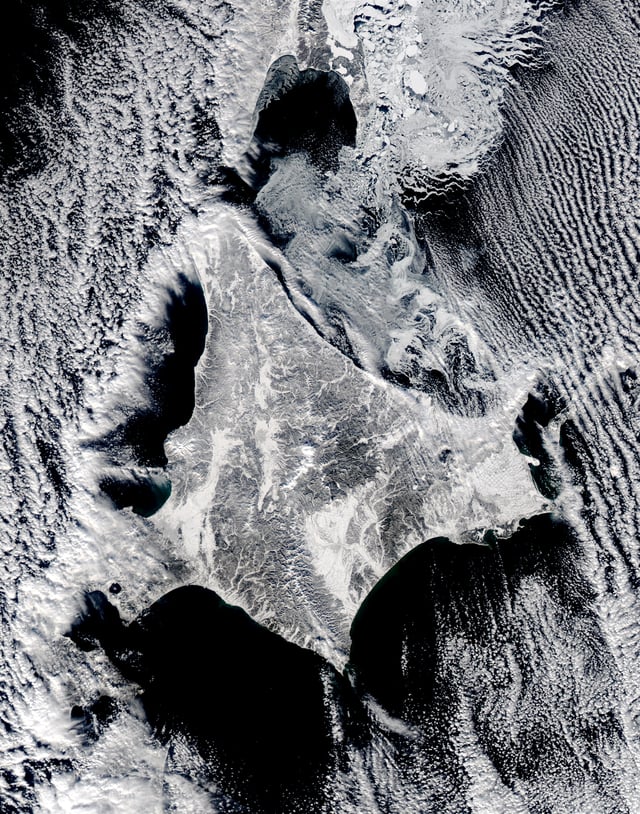
Satellite image of Hokkaido in winter
Japan's coldest region, Hokkaido has relatively cool summers and icy/snowy winters. Most of the island falls in the humid continental climate zone with Köppen climate classification Dfb (hemiboreal) in most areas but Dfa (hot summer humid continental) in some inland lowlands. The average August temperature ranges from 17 to 22 °C (62.6 to 71.6 °F), while the average January temperature ranges from −12 to −4 °C (10.4 to 24.8 °F), in both cases depending on elevation and distance from the ocean, though temperatures on the western side of the island tend to be a little warmer than on the eastern. Highest temperature ever recorded is 39.5C on 26 May 2019.[27]
The northern portion of Hokkaido falls into the taiga biome[28] with significant snowfall. Snowfall varies widely from as much as 11 metres (400 in) on the mountains adjacent to the Sea of Japan down to around 1.8 metres (71 in) on the Pacific coast. The island tends to see isolated snowstorms that develop long-lasting snowbanks, in contrast to the constant flurries seen in the Hokuriku region. Total precipitation varies from 1,600 millimetres (63 in) on the mountains of the Sea of Japan coast to around 800 millimetres (31 in) (the lowest in Japan) on the Sea of Okhotsk coast and interior lowlands and up to around 1,100 millimetres (43 in) on the Pacific side.
Unlike the other major islands of Japan, Hokkaido is normally not affected by the June–July rainy season and the relative lack of humidity and typically warm, rather than hot, summer weather makes its climate an attraction for tourists from other parts of Japan.
In winter, the generally high quality of powder snow and numerous mountains in Hokkaido make it a popular region for snow sports. The snowfall usually commences in earnest in November and ski resorts (such as those at Niseko, Furano, Teine and Rusutsu) usually operate between December and April. Hokkaido celebrates its winter weather at the Sapporo Snow Festival.
During the winter, passage through the Sea of Okhotsk is often complicated by large floes of drift ice. Combined with high winds that occur during winter, this frequently brings air travel and maritime activity to a halt beyond the northern coast of Hokkaido. Ports on the open Pacific Ocean and Sea of Japan are generally ice-free year round, though most rivers freeze during the winter.
Major cities and towns

Hokkaido's largest city, Sapporo
Hokkaido's largest city is the capital, Sapporo, which is a designated city. The island has two core cities: Hakodate in the south and Asahikawa in the central region. Other important population centers include Rumoi, Iwamizawa, Kushiro, Obihiro, Kitami, Abashiri, Wakkanai, and Nemuro.

